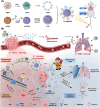Smart biomimetic "nano-med-fireman" blocking inflammation and lactate metabolism crosstalk for normalized spatiotemporal photo-immunotherapy
- PMID: 40496624
- PMCID: PMC12149550
- DOI: 10.1016/j.bioactmat.2025.05.012
Smart biomimetic "nano-med-fireman" blocking inflammation and lactate metabolism crosstalk for normalized spatiotemporal photo-immunotherapy
Abstract
The immense complexity and interconnectedness of inflammation and metabolism in the primary tumor ecosystem and pre-metastatic niches (PMN) present an enormous challenge for developing advanced nano-medicines for cancer immunotherapy. Herein, an intelligent tumor- and PMN-tropic bioactive "nano-med-fireman" (PsiL@M1M) was developed to not only arouse an appropriate photothermal immune cascade but also to "extinguish" the accompanying excessive inflammation. Ultimately, it aims to revitalize the immunosuppressive tumor microenvironment (TME) to spatiotemporally and effectively inhibit tumor metastasis and recurrence. PsiL@M1M was devised by incorporating the siRNA of lactate dehydrogenase A (siLDHA) on the functionalized photothermal mesoporous polydopamine (mPDA) and coupled with an M1-type macrophage membrane (M1M) to enable the capacity of inflammation targeting and modulation. PsiL@M1M actively accumulated and destroyed the primary tumor via photothermal therapy and subsequently mitigated the photothermal therapy-induced inflammatory cascade (e.g., epithelial mesenchymal transition) via cytokine neutralization, eliminating the supply of tumor-derived secretory factors as "nutrients" for PMN. Concurrently, siLDHA interfered with lactate (LA) production, inhibited inflammation-LA communication and relieved immune checkpoint, thus profoundly reversing the immunosuppressive microenvironment of both the primary tumor and PMN. Through cooperation, PsiL@M1M initiated normalized hypo-inflammatory photo-immunotherapy against both local tumor growth and spontaneous metastasis/recurrence. Our study provides a paradigm for a new generation of photothermal nano-medicines for the whole process of tumor treatment.
Keywords: Cytokine neutralization; Inflammation modulation; Lactate metabolism regulation; Photothermal immunotherapy; Pre-metastatic niche reprogramming.
© 2025 The Authors.
Conflict of interest statement
The authors declare that they have no conflicts of interest.
Figures










Similar articles
-
Functionalized biomimetic nanoparticles combining programmed death-1/programmed death-ligand 1 blockade with photothermal ablation for enhanced colorectal cancer immunotherapy.Acta Biomater. 2023 Feb;157:451-466. doi: 10.1016/j.actbio.2022.11.043. Epub 2022 Nov 25. Acta Biomater. 2023. PMID: 36442821
-
ROS-responsive core-shell nano-inhibitor impedes pyruvate metabolism for reinforced photodynamic therapy and interrupted pre-metastatic niche formation.Acta Biomater. 2024 Jul 1;182:288-300. doi: 10.1016/j.actbio.2024.05.016. Epub 2024 May 9. Acta Biomater. 2024. PMID: 38729547
-
Photothermal "nano-dot" reactivate "immune-hot" for tumor treatment via reprogramming cancer cells metabolism.Biomaterials. 2023 May;296:122089. doi: 10.1016/j.biomaterials.2023.122089. Epub 2023 Mar 6. Biomaterials. 2023. PMID: 36898223
-
Small extracellular vesicle-mediated metabolic reprogramming: from tumors to pre-metastatic niche formation.Cell Commun Signal. 2023 May 19;21(1):116. doi: 10.1186/s12964-023-01136-x. Cell Commun Signal. 2023. PMID: 37208722 Free PMC article. Review.
-
Nanoengineered Platform-Based Microenvironment-Triggered Immunotherapy in Cancer Treatment.Front Biosci (Landmark Ed). 2024 Oct 8;29(10):349. doi: 10.31083/j.fbl2910349. Front Biosci (Landmark Ed). 2024. PMID: 39473401 Review.
References
-
- Hanahan D. Hallmarks of cancer: new dimensions. Cancer Discov. 2022;12(1):31–46. - PubMed
-
- Propper D.J., Balkwill F.R. Harnessing cytokines and chemokines for cancer therapy. Nat. Rev. Clin. Oncol. 2022;19(4):237–253. - PubMed
-
- de Visser K.E., Joyce J.A. The evolving tumor microenvironment: from cancer initiation to metastatic outgrowth. Cancer Cell. 2023;41(3):374–403. - PubMed
-
- Diakos C.I., Charles K.A., McMillan D.C., Clarke S.J. Cancer-related inflammation and treatment effectiveness. Lancet Oncol. 2014;15(11):e493–503. - PubMed
LinkOut - more resources
Full Text Sources

